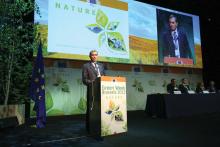
Years ago, workers at the quarry of Quenast in Belgium spent long days at the gruelling task of handcrafting iron-hard cobblestones for city streets around the world, including New York. However, the quarry’s most important product was its high quality gravel.
Today, all that has gone, and while there is still evidence of the site of the old industry at the quarry, 30km south-west of Brussels, the land is now partly used for a gentler purpose: to highlight nature and biodiversity.
The 2.4km trail around the top of the ancient quarry, one of Europe’s largest, is dotted with information boards about what can be seen and heard, and this includes rare creatures and plants.
Even as 3.5tonnes of explosives blasts 20,000tonnes of rock in the quarry, which is run by
Nesting buzzards, peregrine falcons, eagle owls, little ringed plovers and blackcaps can be seen, along with with more common birds along the trail, and in 2014 a total of 44 bats from six species were recorded, having made their home in an old disused tunnel once used by workers.
Behind another old building overlooking the quarry, a local honey producer has set up his beehives to take advantage of the flora, while in the shadow of another impressive disused building, near where long-gone tracks were used to wheel material in and the finished cobblestones out, rare lichen has taken over.
All this, and more, is set against the backdrop of the Quenast quarry, a porphyry deposit, on a 365hectares area, of which some 90hectares is exploited. Porphyry is a variety of igneous rock known for its hardness and durability (the porphyry of Quenast consists for over 80% of Feldspar) and its exploitation in the area goes back to the 16th century.
Today the quarry, in area and depth, is one of Europe’s largest quarries, with an annual capacity of 2 million tonnes and reserves estimated at 140 million tonnes.
Originally, its cobblestones were used for roads (they can still be seen in many old roads in Belgium and France) but today the main product is gravel for projects where hardness, durability and resistance is of great importance.
Porphyry from the area was used in the huge Delta Works in Holland; in the tunnel between France and the UK, and for the high-speed TGV tracks.Today four porphyry quarries are operated (from east to west): Quenast, Bierghes, and the side-by-side quarries of Lessines and Deux-Acren. During the recent Green Week, held in Brussels, Under the umbrella of the recent 2015 edition of Green Week, held in Brussels, delegates were offered the opportunity to learn more about the biodiversity and nature thriving in cement and aggregate quarries with a tour of the Quenast quarry trail, organised by Birdlife International;
“It is then transported by belt conveyors from the quarry to the plant where we have further crushing and screening equipment. About 20% of annual production is moved by rail; 65% by road and 15% by boat.
“The environment and biodiversity are among our main objectives, and I am very proud to have created a very nice natural trip along the quarry. Many people have worked to make this a success.”
Indeed, the UEPG pointed out that “astonishingly certain species you find only in quarries and only in the extraction part.”
Dido Gosse, of Heidelberg Cement, says the trail, which has 25 explanatory signs at 12 viewing points, was created in 2013, and some 25 groups have already visited it.
She points out that water, removed from the quarry to a central pond, also attracts wildlife, and after settling and treatment it can be used in the plant. When the pond is overfull it is released into the local Senne River.








